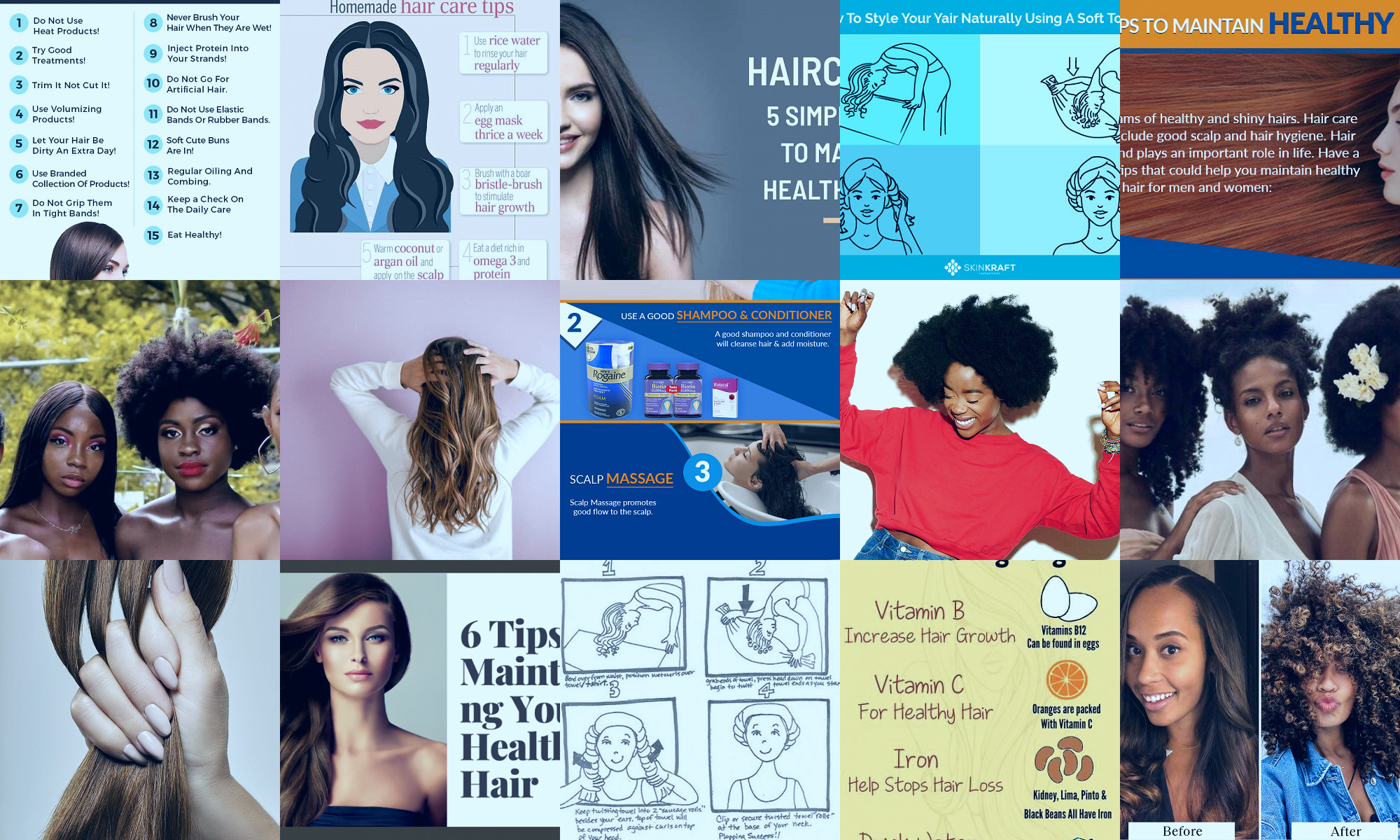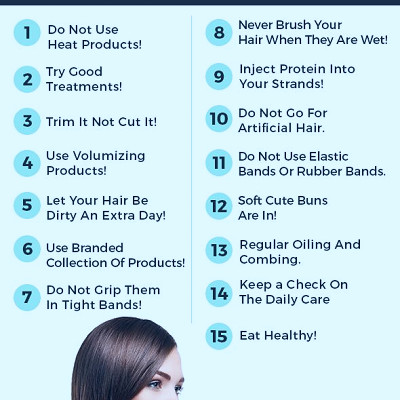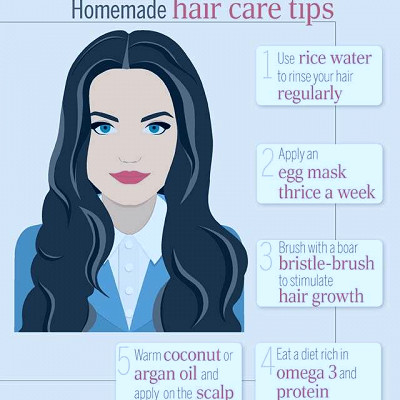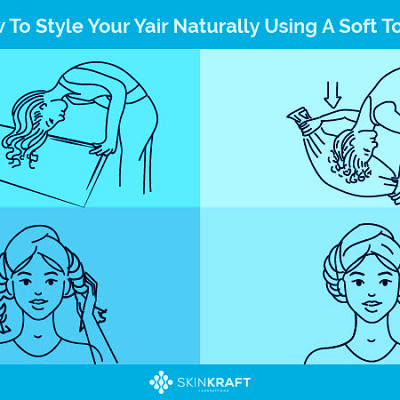 Jarlat Maletych/Shutterstock
Jarlat Maletych/Shutterstock
Features
Understanding Hair Structure
Knowing the anatomy of the hair strand is crucial to maintaining healthy hair. Hair is made up of a protein called keratin and has three layers: the cuticle, cortex, and medulla. Keeping these layers healthy ensures strong, shiny hair.
Balanced Diet
Nutrition plays a significant role in hair health. A diet rich in vitamins A, B, C, D, E, iron, selenium, and zinc can help promote hair growth and prevent hair loss. These nutrients are found in foods like eggs, berries, spinach, and avocados.
Regular Hydration
Drinking plenty of water helps in hydrating the scalp which in turn keeps your hair healthy. Dehydration can lead to dry scalp, making the hair brittle and prone to breakage.
Avoid Heat Styling
Excessive use of heat styling tools can damage the hair cuticle, leading to dryness and breakage. It's important to use these tools sparingly and always apply a heat protectant before styling.
Proper Shampooing
Over-shampooing can strip the hair of its natural oils, leading to dryness and breakage. It's recommended to shampoo your hair only when necessary (usually 2-3 times a week), using gentle, sulfate-free shampoos.
Regular Conditioning
Conditioners provide the hair with the necessary hydration and nutrients it needs to stay healthy. Always apply conditioner after shampooing, focusing on the ends of the hair where damage is most likely to occur.
Hair Masks
Hair masks are intensive treatments that provide deep nourishment to the hair. They are typically used once a week and can be made from natural ingredients like avocado, honey, and coconut oil.
Regular Trimming
Trimming the hair regularly helps to remove split ends and prevent further damage. It's recommended to get a trim every 6-8 weeks.
Protecting Hair from Sun Exposure
Excessive sun exposure can damage the hair cuticle, leading to dryness and discoloration. It's important to protect your hair by wearing a hat or using a UV protectant spray.
Scalp Massages
Massaging the scalp helps to stimulate blood flow, which in turn promotes hair growth. It's recommended to massage your scalp for a few minutes each day using your fingertips or a scalp massager.
Avoid Chemical Treatments
Chemical treatments like hair coloring and perms can damage the hair cuticle, leading to dryness and breakage. It's important to limit these treatments as much as possible.
Use of Hair Supplements
Supplements like biotin, folic acid, and omega-3 fatty acids can help promote hair growth and prevent hair loss. However, they should only be used under the guidance of a healthcare professional.
Gentle Brushing
Brushing the hair gently helps to distribute natural oils from the scalp to the ends of the hair. It's recommended to use a wide-tooth comb or a brush with soft bristles.
Use of Silk Pillowcases
Silk pillowcases can help to reduce friction and prevent hair breakage while you sleep. They also help to maintain the hair's natural oils.
Regular Exercise
Regular exercise promotes overall health, including hair health. It helps to stimulate blood flow, which in turn promotes hair growth.
Manage Stress
High stress levels can lead to hair loss. It's important to manage stress through activities like yoga, meditation, and regular exercise.
Avoid Tight Hairstyles
Tight hairstyles like ponytails and braids can cause tension on the hair follicles, leading to hair loss over time. It's important to wear your hair loose as often as possible.
Limit Chlorine Exposure
Chlorine can strip the hair of its natural oils, leading to dryness and breakage. It's recommended to wear a swim cap when swimming in chlorinated pools.
Regular Detoxification
Using a clarifying shampoo once a month can help to remove product buildup and toxins from the hair and scalp.
Healthy Lifestyle
A healthy lifestyle that includes a balanced diet, regular exercise, and adequate sleep can promote overall hair health. It's also important to avoid smoking and limit alcohol consumption, as these can negatively affect hair health.
Interesting notes and facts
1. Eat a Balanced Diet: The health of your hair is directly linked to your diet. Consuming a balanced diet rich in vitamins A, C, D, and E, as well as plenty of protein and iron, can improve hair growth. Foods like eggs, berries, spinach, and avocados are particularly beneficial.2. Stay Hydrated: Lack of hydration can lead to dry, brittle hair. Make sure to drink at least eight glasses of water a day to keep your hair healthy and hydrated. Plus, the hydration provided by water helps in enhancing the texture and appearance of your hair.
3. Avoid Heat Styling Tools: Excessive use of heat styling tools like hair dryers, curling irons, and straighteners can damage your hair over time, leading to split ends and breakage. Try to limit the use of these tools and always use a heat protectant spray when you do.
4. Regular Trims: Even if you're growing out your hair, regular trims are essential for maintaining healthy hair. They help to remove split ends and prevent further damage. Aim for a trim every six to eight weeks.
5. Minimize Chemical Treatments: Chemical treatments such as hair coloring, perming, and straightening can severely damage your hair. Try to minimize the use of these treatments or opt for natural alternatives.
6. Protect Your Hair: Protect your hair from sun, wind, and rain. Exposure to excessive sun, heat, dirt, and pollution adds to our hair woes. These can lead to dirt build up, drying out of hair and scalp, and increased susceptibility to infections on the scalp.
7. Wash Your Hair Properly: Overwashing can dry out your hair, while under washing can lead to build-up. Find a balance that works for your hair type, and try to use a shampoo and conditioner that are free of sulfates and parabens.
8. Don’t Tie Your Hair Too Tight: Traction alopecia is a serious problem that arises from pulling the hair back very tightly. Avoid tying your hair in tight ponytails, buns, or braids as it can cause breakage and pull out hair from the roots.
9. Maintain a Healthy Scalp: A healthy scalp is the foundation for healthy hair. Exfoliate your scalp regularly to remove dead skin cells and stimulate blood flow. This can also help to reduce dandruff and other scalp issues.
10. Get Regular Check-ups: Regular check-ups can help spot any issues early before they become major problems. If you notice any changes in your hair or scalp, such as excessive hair loss or changes in texture, it's best to consult with a healthcare professional.
Vocabulary
- Balanced Diet – A diet rich in vitamins, minerals, and proteins necessary for hair growth and maintenance.
- Hydration – The intake of sufficient water to maintain proper body and hair health.
- Hair Washing – The process of cleaning the hair and scalp with water and shampoo to remove dirt, oil, and other build-ups.
- Conditioner – A hair care product used after shampooing to moisturize and protect the hair.
- Hair Masks – Intensive treatments used to deeply nourish and repair damaged hair.
- Hair Brushing – The process of running a brush through the hair to detangle, spread natural oils, and stimulate the scalp.
- Heat Styling – The use of heated tools like straighteners and curling irons to style hair, which can cause damage if not used properly.
- Hair Dye – A product used to change the color of the hair.
- Haircut – The process of cutting the hair to maintain its shape and remove split ends.
- Split Ends – The fraying or splitting of hair shafts due to damage.
- Scalp Care – The practice of maintaining a healthy scalp through exfoliation, hydration, and balancing oil production.
- Hair Growth Cycle – The stages of growth, rest, and shedding that every hair goes through.
- Hair Follicles – The part of the skin that grows hair.
- Hair Types – Different categories of hair characterized by their texture and curl pattern, including straight, wavy, curly and kinky.
- Hair Loss – The thinning or shedding of hair beyond normal levels.
- Alopecia – A medical condition that causes hair loss.
- Dandruff – A scalp condition characterized by flaking skin.
- Trichology – The scientific study of the hair and scalp.
- Hair Products – Various products like sprays, gels, mousses and serums used to style, protect, and maintain the hair.
- Hair Oils – Oils like coconut, olive, and argan oil used for hair nourishment and shine.
- Protein Treatments – Treatments used to strengthen the hair and repair damage.
- Hair Porosity – The hair’s ability to absorb and retain moisture.
- Hair Density – The number of individual hair strands on the scalp.
- Hair Thinning – Reduction in the density or thickness of the hair.
- Hair Breakage – The snapping or breaking off of hair strands due to damage.
- Hair Vitamins – Supplements taken to promote hair health and growth.
- Hair Hydration – The process of ensuring your hair retains enough moisture.
- Deep Conditioning – A process of conditioning the hair using a rich conditioning product for a prolonged period.
- Heat Protectant – A product used before heat styling to protect the hair from damage.
- Hair Serums – Products used to protect, nourish, and manage hair.
- Hair Shaft – The part of the hair that is visible above the scalp.
- Scalp Massage – A technique used to stimulate blood flow to the hair follicles.
- Detangling – The process of removing knots and tangles from the hair.
- Hair Elasticity – The ability of hair to stretch and return to its original shape without breaking.
- Hair Texture – The natural look and feel of hair, including aspects like thickness and curl pattern.
- Sulfate-Free Shampoo – A type of shampoo that does not contain sulfates, chemicals that can strip hair of natural oils.
- Hair Moisture Balance – The balance between protein and moisture in the hair.
- Hair Frizz – Hair that does not align with the surrounding hairs but stands up or curls independently, creating a fuzzy or irregular texture.
- Hair Gloss – A type of hair treatment that adds shine to the hair.
- Keratin – A type of protein that is a main component of hair.
- Sebum – The natural oil produced by the body's sebaceous glands, which helps to moisturize and protect the hair and skin.
- Hair Bulb – The part of the hair follicle that is at the base of the hair root.
- Hair Cuticle – The outermost part of the hair shaft, which is layered in a protective formation.
- Hair Medulla – The innermost layer of the hair shaft, which is not always present in every hair type.
- Hair Cortex – The middle layer of the hair shaft, which gives the hair its strength, texture, and color.
- Hair Color – The pigmentation of hair follicles due to two types of melanin: eumelanin and pheomelanin.
- Hair Dryness – A condition where hair lacks enough moisture, leading to brittleness and frizz.
- Hair Graying – The loss of pigmentation in hair, giving it a silver or



